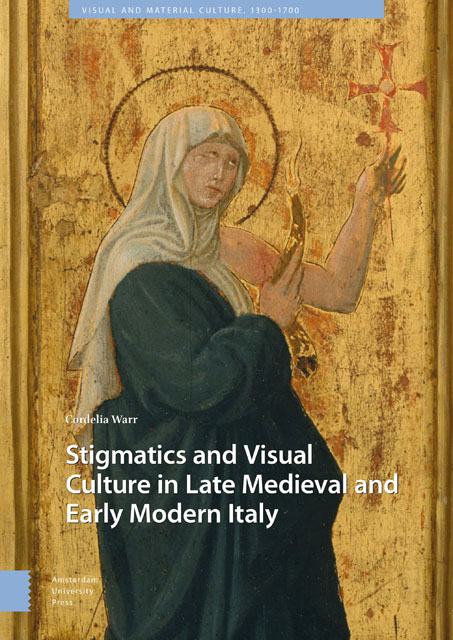Book contents
- Frontmatter
- Table of Contents
- Acknowledgements
- List of Illustrations
- 1 Introduction: Stigmata and Visual Culture
- 2 Saint Francis of Assisi as Image
- 3 Representing the Invisible: Saint Catherine of Siena’s Stigmatization
- 4 The Stigmatic Spectrum and the Visual Arts
- 5 Gregorio Lombardelli, Invisibility, and the Representation of Saint Catherine of Siena’s Stigmata
- 6 Performing Stigmata
- 7 Painting, Printing, Sculpting, Forgery (and Washing)
- 8 Conclusion: The Timidity of the Visual Arts
- Complete Bibliography
- Index
7 - Painting, Printing, Sculpting, Forgery (and Washing)
Published online by Cambridge University Press: 06 December 2022
- Frontmatter
- Table of Contents
- Acknowledgements
- List of Illustrations
- 1 Introduction: Stigmata and Visual Culture
- 2 Saint Francis of Assisi as Image
- 3 Representing the Invisible: Saint Catherine of Siena’s Stigmatization
- 4 The Stigmatic Spectrum and the Visual Arts
- 5 Gregorio Lombardelli, Invisibility, and the Representation of Saint Catherine of Siena’s Stigmata
- 6 Performing Stigmata
- 7 Painting, Printing, Sculpting, Forgery (and Washing)
- 8 Conclusion: The Timidity of the Visual Arts
- Complete Bibliography
- Index
Summary
Abstract
The display of stigmata in images was subject to scrutiny, debate, controversy, and censorship. Conversely, when stigmata were described or discussed in texts their visual qualities could be emphasized using multiple strategies. This chapter explores ways in which texts brought visuality to bear on contemporary understandings of female stigmatics, arguing that an emphasis on the visual and the use of comparisons and juxtapositions with visual art were crucial elements in the formulation, interrogation, and understanding of stigmatic identity, genuine or fraudulent. Ways of construing stigmata in textual material were related to the variety of stigmatic experience, the diversity of the physical appearance of the stigmata, and the number of stigmatics as well as understandings of images and image making.
Keywords: visuality, Veronica, coins, seals, fraud
The display of stigmata in images was subject to scrutiny, debate, controversy, and censorship. Conversely, when stigmata were described or discussed in texts, including hagiographies, their visual qualities could be emphasized using a variety of strategies. This chapter considers some of the ways in which texts brought visuality to bear on contemporary understandings of female stigmatics, arguing that an emphasis on the visual and the use of comparisons and juxtapositions with visual art – including painting, printing, and sculpting – were crucial elements in the formulation, interrogation, and understanding of stigmatic identity, genuine or fraudulent. The ways of construing stigmata in textual material were related to the variety of stigmatic experience, the diversity of the physical appearance of the stigmata, and the number of stigmatics as well as understandings of images and image making. This is, therefore, a messy subject that can appear to frustrate attempts to build a coherent narrative or trajectory. Yet it is precisely within thismess that it is possible to discern the thread that demonstrates, in diverse ways, the importance of visuality and the visual arts in relation to attempts to understand and interpret stigmata.
The process of stigmatization was one in which the recipient became, in some sense, an image of Christ crucified, as discussed in relation to Saint Francis of Assisi in Chapter 2.
- Type
- Chapter
- Information
- Publisher: Amsterdam University PressPrint publication year: 2022



